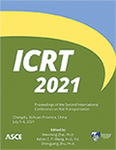Second International Conference on Rail Transportation
Influence of Fluctuating Gust on Metro Train-Bridge System with High Piers
Publication: ICRT 2021
ABSTRACT
To ensure the ride quality of metro system in mountain cities, the characteristics of the wind-train-bridge system with high piers are studied, and the threshold of wind speeds and pier heights are determined in this paper. The representative crosswind model of Chinese hat fluctuating gust considering the speed-up effect of mountain terrain is established. The time series of this wind load is input to the dynamic system. The finite element method is used to model the bridge and the track, the multi-rigid-body system connected with the suspension spring and the damper is used to model each vehicle in the train. The whole process of the metro train running on the three-span high pier viaduct is simulated. On this basis, the analysis of the characteristics such as gust loading, different marshaling modes, wind speeds, and pier heights are taken into account. The study shows that the Chinese hat fluctuating gust model plays an essential role and resonates with the bridge structure in low frequencies, the crosswind stability of trains on high piers is more sensitive than short piers, the critical wind speed is 10.8 m/s and the critical pier height is 63 m.
Get full access to this article
View all available purchase options and get full access to this chapter.
ACKNOWLEDGMENTS
The research described in this paper was financially supported by National Natural Science Foundation of China (No.51408434 and No.11772230), the Basic Natural Science and Frontier Technology Research Program of the Chongqing Municipal Science and Technology Commission (No.cstc2018jcyjAX0271) and the Science and Technology Research Program of Chongqing Municipal Education Commission (No.KJQN201900719).
REFERENCES
BS EN 14067-6 (2018), Railway applications-Aerodynamics-Part 6: Requirements and test procedures for cross wind assessment, British Standards Institution, London, British.
BS EN 1991-1-4 (2005), Eurocode 1: Actions on structures-Part 1–4: General actions-Wind actions, British Standards Institution, London, British.
Cai, C.S., Hu, J.X., Chen, S., Han, Y., Zhang, W. and Kong, X. (2015), “A coupled wind-vehicle-bridge system and its applications: a review”, Wind Struct., 20(2), 117–142.
Cai, C.S., Zhang, W., Liu, X.Z., et al. (2013), “Framework of wind-vehicle-bridge interaction analysis and its applications”, Journal of Earthquake and Tsunami, 7(3) 1350020, 1–27.
Carsten, P. and Zhang, X.Y. (2015), “Influence of uncertainties on crosswind stability of vehicles”, IUTAM Symposium on Dynamical Analysis of Multibody Systems with Design Uncertainties, Univ. Stuttgart, Stuttgart, Germany, Jun.
Chen, Z.W., Han, Z.L., Zhai, W.M. and Yang, J.Z. (2019), “TMD design for seismic vibration control of high-pier bridges in Sichuan-Tibet Railway and its influence on running trains”, Vehicle Syst. Dyn., 57(2), 207–225.
Cai, C.B., He, Q.L., Zhu, S.Y., Zhai, W.M. and Wang, M.Z. (2019), “Dynamic interaction of suspension-type monorail vehicle and bridge: numerical simulation and experiment”, Mech. Syst. Signal Pr., 118, 388–407.
GB/T 50157-2013 (2013), Code for design of metro, China Building Industry Press, Beijing, China. (in Chinese)
Guo, W.W., Xia, H. and Xu, Y.L. (2010), “Running safety analysis of a train on the Tsing Ma Bridge under turbulent winds”, Earthq. Eng. Eng. Vib., 9, 307–318.
Hang, J., and Zhang, Y.S. (2018), “Theoretical research on viaduct vehicles and bridge vibration” Urban rail transit research, 4, 83–87. (in Chinese)
Li, X.Z., Wang, M., Xiao, J., et al. (2014), “Experimental study on aerodynamic characteristics of high-speed train on a truss bridge: A moving model test”, J. Wind Eng. Ind. Aerod., 179, 26–38.
Sun, Y., Li, Z.L., Huang, H.J., et al. (2011), “Experimental research on mean and fluctuating wind speed in hilly terrain wind field”, Acta Aerodynamica Sinica, 29(5), 593–599. (in Chinese)
Xia, H., Guo, W.W., Zhang, N. and Sun, G.J. (2008), “Dynamic analysis of a train-bridge system under wind action”, Comput. Struct., 86(19–20), 1845–1855.
Xia, H., Guo, W.W., Zhang, N. (2017), Dynamic Interaction of Train-Bridge Systems in High-Speed Railways: Theory and Applications, Beijing Jiaotong University Press, Beijing, China.
Yu, M.G., Zhang, J.Y. and Zhang, W.H. (2012), “Running safety of high-speed trains on bridges
Zhai, W.M., Wang, K.Y. and Cai, C.B. (2009), “Fundamentals of vehicle-track coupled dynamics”, Veh. Syst. Dyn. 47, (11)1349–1376.
Zhang, Y.F., Li, J., Chen, Z.W. and Xu, X.Y. (2019). “Dynamic analysis of metro vehicle traveling on a high-pier viaduct under crosswind in Chongqing”, Wind Struct., 29(5), 299–312.
Information & Authors
Information
Published In
ICRT 2021
Pages: 111 - 119
Editors: Wanming Zhai, Ph.D., Southwest Jiaotong University, Kelvin C. P. Wang, Ph.D., Oklahoma State University, and Shengyang Zhu, Ph.D., Southwest Jiaotong University
ISBN (Online): 978-0-7844-8388-6
Copyright
© 2022 American Society of Civil Engineers.
History
Published online: Feb 8, 2022
Authors
Metrics & Citations
Metrics
Citations
Download citation
If you have the appropriate software installed, you can download article citation data to the citation manager of your choice. Simply select your manager software from the list below and click Download.
